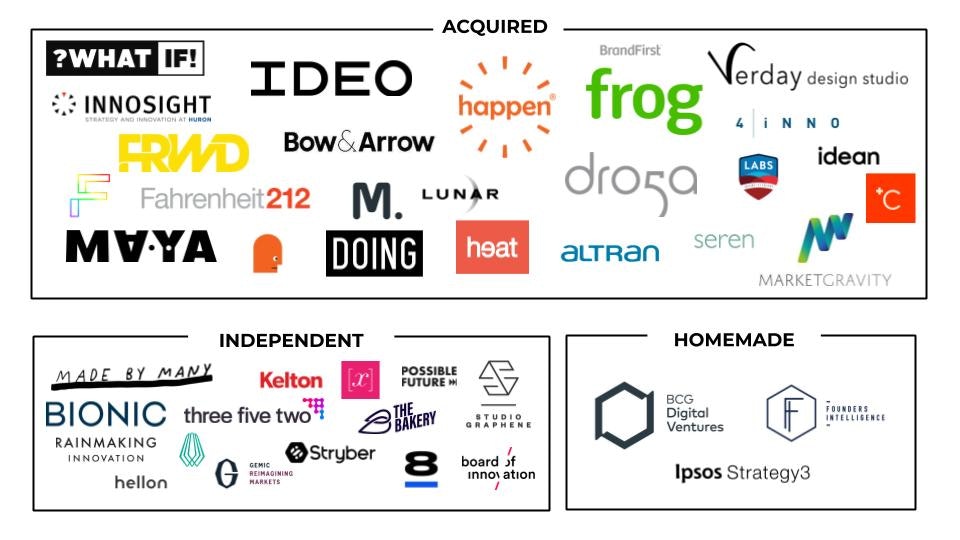This is an ongoing series about "unsexy innovation", looking at some of the hidden, practical problems that kill innovation projects, based on my time working on inhouse M&A, startup partnerships and innovation consulting. The aim is to dive into the areas gurus have never experienced and arm you with tangible lessons for your work.
One of the most salient problems of corporate innovation is that — despite all the products and services available — no one teaches you how to buy services or work with innovation providers.
This means everyone has to learn lessons the hard way, making it harder to tell the snake oil from the rocket fuel.
I’ve sat on both sides of the table, as a corporate buyer and now as a consultant. And one of the key barriers I see is that corporates aren’t clear about what they want, startups/ services providers assume they know and everyone ends up frustrated.
Corporates aren’t clear about what they want, startups assume they know and everyone ends up frustrated.
When buyers don't know what they want
On the corporate side, when we first explored venturing I put out a request for project (RFP) to every innovation consultancy I could find. The results were a real mix of prices, methodologies and offerings, none of which I could gauge the value of.
One of the most interesting parts of the process was realising that innovation providers don’t really communicate with each other or have any consistency of language. This leads to a rich variety of offerings all badged as innovation but doing totally different things, it's safe to say I wasted a lot of my director’s time bringing in agencies who did PR but not hard commercialisation and boutiques that had no global reach and so on.
If this was confusing for us as buyers, it must have been even more frustrating for the sellers. We had no idea what we wanted and had to spend a lot of time scouting to find out what was out there.
When there is no real budget
In a later project I then ran a fintech startup programme to connect UK fintechs with a Japanese retail banking consortium to see if there were cross-sale opportunities. We got our requirements, promoted the event, startups pitched, questions were asked.
Then it became awkwardly clear that this was, in fact, a marketing exercise with no real infrastructure in place to let the tech port internationally, or connect to buyers… even as an inside stakeholder this wasn’t apparent until we got in the room with the startups.
One head of strategy once took me aside to say “it's really positioning for us and makes us look more relevant, so carry on & make all the right noises for now”.
As my time seconded to work inside Level39 taught me, companies and countries often do ceremonial projects to “look like they’re doing the right thing” with their left hand while their right hand carries on with business as usual. It is a misdirect that can blindside eager dealmakers and the people running the corporate/ company programmes alike. One head of strategy once took me aside to say “it's really positioning for us and makes us look more relevant, so carry on & make all the right noises for now”.
So for both parties, be cautious before going all in and focus on generating revenue together or securing an investment as quickly as possible. If no one is interested in that, take it as a warning sign.
For any great sales process, both parties need to understand the problem being solved and how to best construct an offer that solves it. Corporates tend to be quite opaque with what they’re trying to do and if they have a budget or not. Equally, sellers over-hype the solution to build confidence, which downplays the risks.
Better conversations
We need to cut the jargon and start getting better at triaging conversations. We need to get better and faster at talking to each other.
What does a great first conversation look like?
But what does a great first conversation look like? In an Innovation Commons session (a community group Asif Faruque and I started to help Corporates, startups and service providers build empathy to get things done by learning from experienced doers) run last year Ajay Arora, Strategic Partner Manager at Google asked just this when we were discussing the challenge.
The first conversation you have is your opportunity to calibrate and work out if you’re both aligned, as Steve Covey, Author of The 7 Habits of Highly Effective People put it: “start with the end in mind”. Be honest about what you want to get from this process. Misaligned expectations lead to warped deals that are lose-lose for both sides.
Empathy lessons for corporates:
- I’ll never stop repeating this one: understand that time zones for startups are highly accelerated (three months for a corporate is twelve months in startup time). Engage quickly but be extremely clear about what your process is for search, buying, integrating and executing.
- Reply quickly, be honest if the deal is going nowhere. Avoid radio silence. This can stall the vendor when they could be doing other revenue-generating work. They have targets, work and goals, respect that.
- Free services/non-cash payment is not a sustainable way to treat startups, they need cash to grow and scale. Use your market power wisely and sustainably, avoid abusive behaviour.
Empathy lessons for startups/service providers:
- Don't assume the corporate knows how to do this. And don’t assume that getting their business will be easy. Ask key questions like “What is your end-to-end process?” and “Could I talk to a partner that you’ve previously gone to market with?” to get a sense of how open and mature their processes are.
- Your buyer will be a project sponsor and the offering bought will consume budget equivalent to salary costs, bad performance will follow the sponsor around for years and decrease their ability to do other projects.
- The activity may be risky. If the service/product fails there could be massive reputational damage to the company that will cost more than the POC/project.
- Don’t over-inflate/over-promise. Be realistic and honest with what the solution can do, misinformation will blow up during the project.
- Internal culture, boards and approval gateways may seem absurd but try to help your sponsor pass through them quickly and arm them with information to speed up the process. The sponsor will be equally frustrated but one deal won’t change the system, it takes time.
Any lack of empathy and understanding causes problems for everyone. Well-intentioned service providers hit long procurement cycles and buyers get their budgets drained by innovation parasites who can’t deliver. With no outcome to show for it — overall confidence in innovation will decrease.
So, how do we get better at this?
Key tips for corporates:
- Top tip from Alpesh Doshi, founder of Fintricity: Build an 'innovation gateway', a clear entry point to your organisation that can help coach executives on how to buy services, and work with service providers to navigate and get things done quickly in the organisation.
- The role of your innovation team is to facilitate between external providers and the internal business.
- Be it startups or consultants, you need a well-organised coach to help the service provider get through the roadblocks and problems at your organisation at speed so you can get the most for your money.
- Share your KPIs so everyone understands the performance hurdles the project needs to pass through.
- Align your procurement, legal and sales teams to make sure you can buy and use services quickly.
- Communicate internally, make it clear why this solution is needed, prepare for handling objections and regularly update internal teams of progress.
- Articulate what your company is trying to achieve, what you need help with and make it visible to the market.
- Ensure you have the holy trinity of project sponsorship: interest, accountability and budget before proceeding, lacking any one of these risks the project becoming a zombie.
Key tips for startups/service providers:
- Be very clear on exactly what problem you solve for the company and which of their customers you appeal to (research annual reports, key speakers, LinkedIn profiles, press statements). Show you’ve tried to understand them — but understand this is likely manicured reality, what they really need will be very different to what they say for shareholder ears.
- Make it as easy as possible for the corporate to sell your product/service internally, provide all details and context that the sponsor needs and tailor it to the company.
- Make it as easy as possible for the corporate to convey the value that your product provides the end customer/corporation — you won’t be the only opportunity they are considering, so make it as easy as possible to choose you.
- Make buying from you a “grease shoot”. Eliminate friction, know your price points and discount rates, have your service contracts ready. Prepare a due diligence pack to make their procurement team feel confident and where possible make any gaps/development needs very clear so the product/service status contains no surprises.
It would be great to discuss this further in the comments section. What are your biggest issues when buying / selling innovation? Are you even aware of what's out there?


